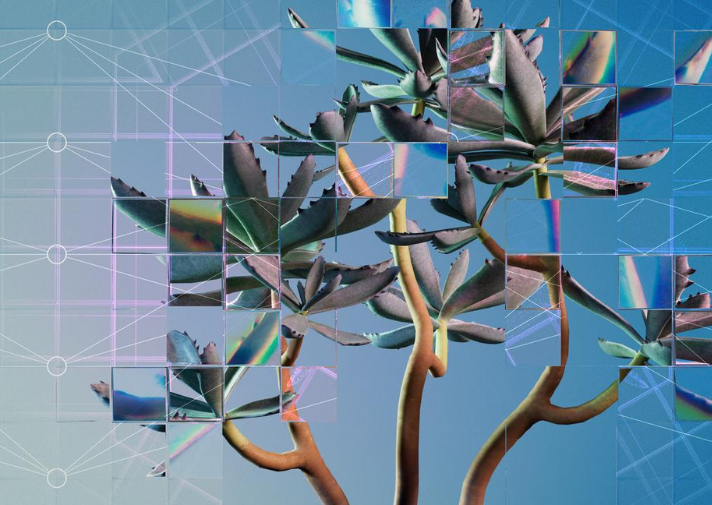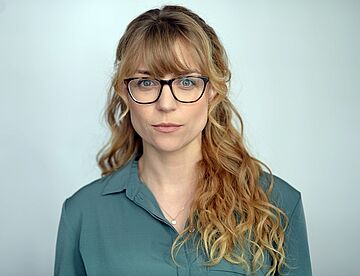
Generative AI and Creativity: “It's not about replacing humans”.
08/17/2023Jennifer Haase conducts research at the Weizenbaum Institute on the potentials of tools like ChatGPT for creative work. In part 2 of our artificial&intelligent? series, she explains how AI systems can be good, supportive partners.
Jennifer, in your research, you've explored the creative abilities of generative AI tools. How do such text or image generators, like ChatGPT or Midjourney, actually work?
Generative AI tools operate based on machine learning, specifically with neural networks known as "transformative models." These models are trained on massive amounts of data, whether it's text, images, or even music, and they learn to recognize and predict patterns from that data. Once they are sufficiently trained, they can generate new material or adapt existing paragraphs or images based on these patterns. ChatGPT has been fed with a vast variety of texts, while Midjourney has been trained with a large amount of visual data.
The output is quite fascinating, but one can also argue that these tools are nothing more than statistical prediction machines. Based on input, they calculate the statistically next best word, pixel, or note. Whether users perceive this output as meaningful, helpful, or even "creative" heavily depends on the input, the knowledge base of the AI systems, and, of course, our interpretation. There is by no means consensus on whether current generative AI tools are truly "intelligent."
How did you go about your research, and how did you define creativity in your approach?
In psychological research, creativity is defined as the creation of something new and useful. With this definition in mind, we asked ourselves whether this definition could also apply to generative AI models like ChatGPT. We subjected six different chatbots, including ChatGPT and Alpa, as well as 100 individuals from an average population to the same five standardized creativity tests. They were asked, for example, "What are uncommon uses for a rope / newspaper / tire?" The answers were then randomly mixed to conceal their origin – whether from AI or humans. In a next step, we had them evaluated by six trained individuals and a specifically trained AI regarding the originality and quantity of the ideas.
What did you find out?
The most intriguing discovery was that, on average, human responses were just as (un)original as those of the six chatbots! In brainstorming ideas, humans don't differ significantly from generative tools. As is typical in psychological studies, we found a wide range of variation among the participants and among the chatbots. Some participants were significantly more original in their ideas, while others were less original. In fact, the most original ideas always came from humans, but the chatbots generated significantly more ideas. However, it's worth noting that this comparison isn't entirely fair because chatbots are designed to generate a lot of output, much of which can be trivial or nonsense.
Are there other forms of creativity where humans are still better than machines?
Certainly! The specific situational knowledge that’s required, especially for more complex creative tasks, often isn’t directly available or can only be retrieved with difficulty by an AI. Additionally, current AI systems always require input prompts from the user. So, the definition and the dimensions of the creative problem are primarily set by humans. The same goes for understanding and implementing the generated ideas. Most of the mental load and engagement is done by us humans.
It has never been easy to create art in the age of the internet. Is the creative industry now facing more pressure from AI competition?
Certainly to some extent, particularly in areas where simple and repetitive art is to be created, and for audiences who are satisfied with simple and "unrefined" art. In the field of game design, for example, we are already seeing the standard use of AI-generated visuals. But for groundbreaking, clever, or situation-specific results, we still need humans.
Our research is not about looking for ways to replace humans or artists. Instead, we aim to understand when and how AI systems can be good partners and supporters. With our study, we have only scratched the surface of creativity.
What effect will the use of these tools have on us? Will we become less creative over time?
That's a very intriguing question for which we don't yet have an answer because the tools are still relatively new. However, we can draw parallels from the history of technology use, and that strongly indicates that it’s up to us how we utilize these tools.
When used to complement our own thinking and creativity, they can enrich us enormously: For example, they can give us more time to contemplate the "big picture" and find creative solutions to complex problems. They can also help us think more broadly and interdisciplinarily by delivering a variety of perspectives and ideas that we might not have considered on our own.
On the other hand, there is a risk that we might rely too heavily on these tools and forget to apply and nurture our own creative abilities. Creative and original thinking requires practice. If we use these tools instead of thinking for ourselves, they could indeed limit us.
Your research has received a lot of attention in the media recently. What bothers you about the debate around ChatGPT and similar technologies, and what gives you hope?
I believe the media debate around ChatGPT and imaging techniques like Midjourney and DALL-E often paints a strongly polarized picture – changing between the idea of AI omnipotence and doomsday scenarios. In my view, there is neither reason to believe that AI will take away all our jobs in the near future nor to fear that these technologies will take over control. We are talking about highly complex technologies that, if used sensibly, offer enormous potential. Our task is now to harness this potential beyond the exaggerated hype and unfounded fears. Fortunately, most recent reports appear to be more nuanced and reflective. The focus is increasingly shifting towards practical and meaningful applications of these tools. This gives me hope that we can create a broad, critically informed user base outside the AI enthusiast bubble.
What questions remain unanswered, and what will you investigate next?
How this will continue to develop over time is indeed fascinating – both in terms of the effects on users and the capabilities of future AI generations. Now that we are aware of the creative abilities of chatbots, we need to analyze their practical applications. Which target groups benefit most from chatbot assistants? In which specific creative tasks can they be particularly supportive? And what kind of support or training is necessary to use them optimally? These are among the questions we need to explore to best design the interaction between humans and machines in creative work.
Thank you very much for the interview!
Jennifer Haase is a research associate in the research group Security and Transparency of Digital Processes. Her research on creativity has been widely covered in the press, including Tagesschau, Frankfurter Rundschau and Harvard Business Review.
She was interviewed by Leonie Dorn
artificial&intelligent? is a series of interviews and articles on the latest applications of generative language models and image generators. Researchers at the Weizenbaum Institute discuss the societal impacts of these tools, add current studies and research findings to the debate, and contextualize widely discussed fears and expectations. In the spirit of Joseph Weizenbaum, the concept of "Artificial Intelligence," is also called into question, unraveling the supposed omnipotence and authority of these systems. The AI pioneer and critic, who developed one of the first chatbots, would have celebrated his 100th birthday this year.
